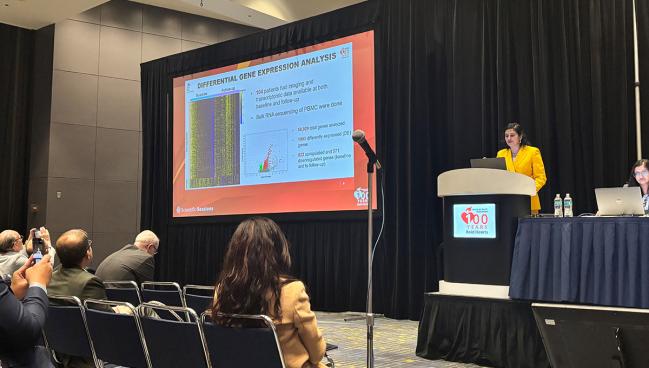Clues to Evolocumab Response Exist in Patients’ Genes: YELLOW III
In the trial, 20% of patients didn’t respond well to the PCSK9 inhibitor—could genetic markers be used to tailor therapy?

Lead investigator Annapoorna Kini, MD (Icahn School of Medicine at Mount Sinai, New York, NY), told TCTMD the insights provided by transcriptomics—analysis of the RNA transcripts that arise from the DNA genotype—might one day, with additional research, be leveraged to personalize medical therapy.
Earlier results from YELLOW III, reported in 2023 at the American College of Cardiology (ACC) annual meeting, showed beneficial changes in plaque morphology when evolocumab is added on top of maximally tolerated statin therapy. The current analysis indicates that these changes may be due to “suppressed inflammation, alleviated oxidative stress, and restored mitochondrial function,” researchers reported at the American Heart Association (AHA) 2024 Scientific Sessions.
Prior studies have established the ability of PCSK9 inhibition to reduce residual CV risk in statin-treated patients. Both the 2019 European dyslipidemia guidelines and the 2018 ACC/AHA cholesterol guidelines recommend use of PCSK9 inhibitors in patients with stable CAD if sufficient LDL cholesterol-lowering is not achieved on maximally tolerated doses of statins and ezetimibe.
However, at least 20% of patients in YELLOW III were nonresponders to evolocumab, Kini told TCTMD. “Their LDL went down—if you look at their blood, their LDL is in the 30s and 40s. But then when we did imaging, their fibrous cap did not become thick and their [lipid core burden index] also did not change. Why are these people different? We found there was a difference in their genetic profile, their expression,” she explained.
Among responders, “when we add evolocumab, it does not just work on decreasing LDL, it also works on important pathways that improve mitochondrial function,” actions that in turn decrease plaque and positively affect the fibrous cap, she added.
Christopher M. Kramer, MD (University of Virginia Health System, Charlottesville), who discussed Kini’s presentation in the featured science session, described YELLOW III as an “absolutely beautiful study helping us understand the mechanism of aggressive LDL-lowering with evolocumab.”
But, he asked, what about residual risk? “There are a significant number of patients who go on to have events on PCSK9s and statins,” Kramer noted, pointing out that it’s not yet clear which preventive strategies would work in this scenario. “I don’t think we can act on the findings on the transcriptomics just yet,” he said, though potential options for further exploration include medical therapies that target inflammation or lipoprotein(a).
Response at a Genetic Level
YELLOW III enrolled 137 CAD patients who were scheduled for elective coronary angiography and had, in addition to a culprit lesion, a 30-50% nonobstructive lesion with OCT-defined lipid-rich plaque. All received 140 mg evolocumab for 26 weeks on top of maximum statin treatment.
Beyond looking at plaque characteristics, YELLOW III researchers isolated peripheral blood mononuclear cells (PBMC) at baseline and follow-up. Imaging and transcriptomic data were available for 104 patients.
The investigators found 571 downregulated transcripts related to pathways modulating cell adhesion, recruitment, and communication. They also identified 922 upregulated transcripts associated with mitochondrial function and protein synthesis.
Eighty percent of the patients in the genetic analysis were considered responders to evolocumab by virtue of having increased fibrous cap thickness on OCT, while 78% were deemed responders thanks to having a significant reduction in maximum lipid core burden index (maxLCBI4mm) on near-infrared spectroscopy.
Through use of machine learning, Kini et al created models informed by 38 genes for fibrous cap thickness and 71 genes for maxLCBI4mm that predicted how patients would respond to evolocumab (area under the curve 0.97 and 0.90, respectively). These signatures included genes related to upregulated interleukin-10 signaling and macrophage alternative activation, wound healing, and neutrophil degranulation.
“Our next goal, to take it to a next level, is to [pinpoint] a biomarker” that could be measured with an assay “before we start them on therapy and then tailor the therapy,” Kini said. The question is whether the patient will respond to statins, a PCSK9 inhibitor, or neither. They haven’t found a genetic marker for statin response yet, she clarified.
Kini’s goal with YELLOW IV, currently in the planning stages, is to further develop and validate such an assay. Additionally, she suggested, “strategies to enhance mitochondrial metabolism could be a promising approach to limiting progression of atherosclerosis.”
Caitlin E. Cox is News Editor of TCTMD and Associate Director, Editorial Content at the Cardiovascular Research Foundation. She produces the…
Read Full BioSources
Kini AS. Transcriptomic signatures and predictors of evolocumab added to maximum statin therapy based on intra-coronary plaque characteristics: YELLOW-III study. Presented at: AHA 2024. November 16, 2024. Chicago, IL.
Disclosures
- YELLOW III was funded by Amgen with partial support from Abbott Vascular.
- Kini and Kramer report having no relevant conflicts of interest.




Comments